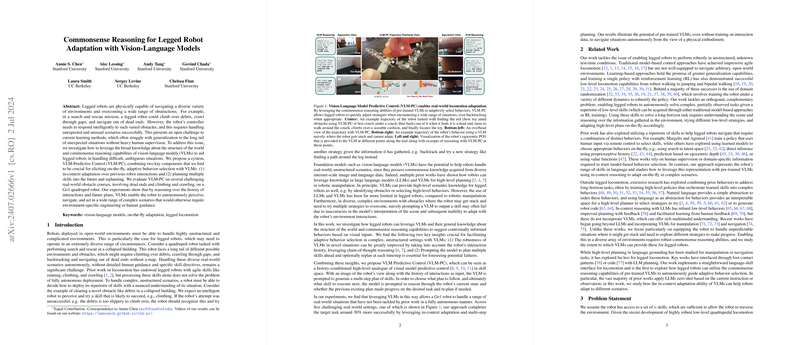Commonsense Reasoning for Legged Robot Adaptation with Vision-LLMs
The paper "Commonsense Reasoning for Legged Robot Adaptation with Vision-LLMs" addresses a pertinent challenge in robotics: enabling legged robots to autonomously navigate complex, unstructured environments. The authors propose an innovative system, Vision-LLM Predictive Control (VLM-PC), which leverages pre-trained vision-LLMs (VLMs) to aid legged robots in perceiving and reasoning about their environment, thereby facilitating adaptive behavior selection and execution.
Overview
The central objective of this research is to enhance the robustness of legged robots in diverse real-world scenarios, reducing the necessity for environment-specific engineering or human intervention. Traditional robotic locomotion methods primarily rely on either model-based control or reinforcement learning (RL) to equip robots with agile skills. However, these methods fall short when the robots encounter unforeseen obstacles or require a nuanced understanding of the environment to decide which skills to deploy.
The proposed VLM-PC system integrates two primary components:
- In-context adaptation over previous robot interactions.
- Planning multiple steps ahead and replanning as necessary.
This dual approach allows the robot to draw from a repository of pre-trained skills and use the commonsense reasoning capabilities of VLMs to select and adapt behaviors on-the-fly.
Methodology
Representing Skills for VLM Integration
The researchers constructed a set of robot behaviors encoded as natural language commands to interface effectively with the VLM. Each behavior corresponds to a specific skill (e.g., walking forward, crawling, climbing) and is parameterized by variables such as x-velocity, gait type, body height, and duration.
In-Context Reasoning
The in-context reasoning approach uses the robot's history of interactions, including previously executed commands and visual observations, to inform future decisions. By leveraging chain-of-thought prompting, the VLM reasons through prior experiences, considering what strategies have been attempted and their effectiveness. This enables the robot to adapt dynamically to evolving situations.
Multi-Step Planning and Execution
To mitigate the partial observability issues inherent in real-world environments, the authors introduced a mechanism for multi-step planning within the VLM. At each decision point, the VLM is prompted to generate a sequence of high-level skill commands, allowing it to foresee and evaluate potential future outcomes. This planning is iteratively refined based on the robot’s ongoing observations and experiences.
Empirical Evaluation
The system was evaluated on a Go1 quadruped robot across five challenging real-world settings, requiring the robot to overcome obstacles such as climbing over logs, crawling under furniture, and navigating dead ends. The performance was measured in terms of task completion time and success rate.
Results
Across the five testing scenarios, VLM-PC demonstrated a notable improvement over baseline methods:
- The success rate for VLM-PC was approximately 64%, outperforming the second-best method by 30%.
- VLM-PC successfully completed tasks in complex settings, such as navigating under and around furniture, by effectively using its commonsense reasoning derived from VLMs.
The results corroborate that the dual approach of in-context reasoning and multi-step planning significantly enhances the robot's capacity to adapt to unprecedented environments.
Implications
Practical Implications:
- Reduced Human Intervention: VLM-PC enables robots to handle a broader range of scenarios autonomously, reducing the dependency on human guidance.
- Enhanced Versatility: By leveraging general knowledge from VLMs, robots can apply their skills more flexibly and effectively, making them suitable for applications like search and rescue missions.
Theoretical Implications:
- Integration of VLMs in Robotics: This work exemplifies the potential of integrating large-scale pre-trained models into robotic systems, providing a foundation for future research on leveraging VLMs and LLMs for real-time robotic decision-making.
- Advancements in Adaptive Control: The successful application of in-context reasoning and multi-step planning may inspire similar approaches in other domains of robotics where adaptability to dynamic environments is crucial.
Future Directions
The future developments could explore:
- Extended Sensor Fusion: Incorporating additional sensors or advanced scene reconstruction to provide a more comprehensive environmental understanding.
- Fine-Tuning of VLMs: Investigating fine-tuning methods, like reinforcement learning from human feedback, to further enhance the model's context-specific reasoning and adaptation.
- Cross-Domain Applications: Extending the principles of VLM-PC to other robotic tasks, including manipulation, to create more versatile and autonomous robotic systems.
In conclusion, the paper contributes significantly to the field of robotics by presenting a systematic approach to leveraging the commonsense reasoning capabilities of VLMs for adaptive behavior selection in legged robots. This innovation holds promise for advancing the autonomy and versatility of robots in real-world applications.
